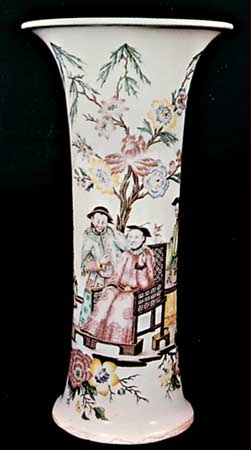Capodimonte porcelain
 soft-paste porcelain produced by a factory established in 1743 at the Palazzo of Capodimonte by Charles III of Naples. Ware was produced there in large quantity and wide variety until 1759, when the concern was dismantled and removed to Buen Retiro, near Madrid, when Charles became king of Spain. Capodimonte is to be distinguished from the products of the royal factory at Naples that Charles's son, Ferdinand IV, founded in 1771 and that was active until 1806. Giuseppe Gricci was chief modeler during the life of the Capodimonte factory, and J.S. Fischer and Luigi Restile were, successively, chief painters.
soft-paste porcelain produced by a factory established in 1743 at the Palazzo of Capodimonte by Charles III of Naples. Ware was produced there in large quantity and wide variety until 1759, when the concern was dismantled and removed to Buen Retiro, near Madrid, when Charles became king of Spain. Capodimonte is to be distinguished from the products of the royal factory at Naples that Charles's son, Ferdinand IV, founded in 1771 and that was active until 1806. Giuseppe Gricci was chief modeler during the life of the Capodimonte factory, and J.S. Fischer and Luigi Restile were, successively, chief painters.The soft-paste body of the porcelain, which has a lustrous glaze, is usually pure white but is sometimes slightly tinged. Early productions—Rococo snuffboxes, cane handles, soup tureens, and tea services—were put on sale at annual fairs. Painted designs included battle scenes, seascapes, landscapes, figures, and cupids in monochrome red, blue, violet, or black; occasionally a turquoise ground, derived from Meissen, was used. Numerous figures and groups were modeled by Gricci, drawing on mythological, religious, or rustic themes. A range of commedia dell'arte characters are vivid creations, distinctive in the restrained use of soft colours and gold. But the decorative masterpiece of the Capodimonte factory is the Rococo “Porcelain Room” originally at the Villa Reale at Portici but moved to the Palazzo of Capodimonte in 1805. Executed between 1757 and 1759, it is still intact except for a chandelier destroyed in World War II. Gricci and Fischer were principally responsible for the room, which, apart from the door and five mirrors, consists entirely of porcelain plaques, vases, and large-relief chinoiserie (decoration reflecting Chinese influence) groups lavishly gilded and brightly painted in polychrome enamel.
Porcelain cups and saucers and similar ornamental wares decorated with mythological scenes in relief and coloured were not at any time made here but were produced at the Doccia factory. The Bourbon fleur-de-lis, impressed or painted, was the factory mark (the same mark subsequently used by Buen Retiro), though it was seldom used.
Porcelain of varying quality continues to be made under the Capodimonte name in Italy, both in the Naples area and at other locations. The modern production includes figurines and heavily decorated vases, urns, chandeliers, and other objects. Realistic floral designs, including individual blossoms, are widely identified with the Capodimonte name.
- Fernando Belaúnde Terry
- Fernando Botero
- Fernando de Herrera
- Fernando del Paso
- Fernando de, Marqués De Villa Sierra Valenzuela
- Fernando de Noronha Island
- Fernando de Rojas
- Fernando de Valenzuela, Marqués De Villa Sierra
- Fernando Francesco de Avalos, marchese di Pescara
- Fernando Francesco de Avalos Pescara, marchese di
- Fernando Goncalves Namora
- Fernando Henrique Cardoso
- Fernando Lugo
- Fernando Monteiro de Castro Soromenho
- Fernando Ortiz
- Fernando Pessoa
- Fernando Romeo Lucas García
- Fernando Valenzuela
- Fernando Wood
- Fernando Álvarez de Toledo y Pimentel, 3er duque de (3rd duke of) Alba
- Fernando Álvarez de Toledo y Pimentel Alba, 3er duque de (3rd duke of)
- Fernand Pelloutier
- fern moss
- Fernán Caballero
- Fernández de Avellaneda, Alonso